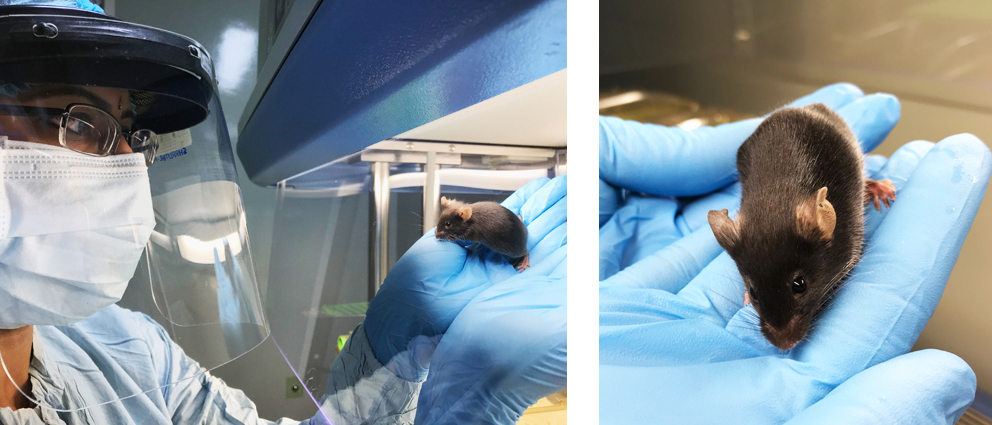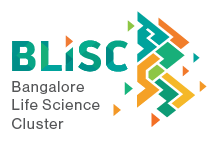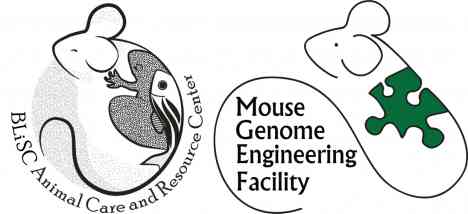BLiSC Animal Care and Resource Center (ACRC) - ACE2 Mice for COVID-19 research
Different ACE2 mouse models available for your COVID-19 research needs:

Photos: BLiSC-ACRC facility staff handling/monitoring a humanized ACE2 mouse.
Understanding the pathogenesis of the virus causing COVID-19, its unexpected effects on multiple organs in the body, and the hope to develop effective treatments and vaccines highlight the need for animal models to understand viral infection and the complex host response they sometimes elicit. Mouse models are the preeminent platform for pre-clinical studies and have provided insights into disease etiology as well as serving as a platform for vaccine and drug development. Studies have shown that the virus causing COVID-19, Severe Acute Respiratory Syndrome Coronavirus (SARS-CoV-2), enters the human body by binding to human angiotensin-converting enzyme 2 (ACE2). However, due to structural differences in mouse ACE2 compared to human ACE2 proteins, rodents are refractory to SARS-Cov-2 infection. Consequently, commonly used wild-type mouse strains are not appropriate for studying infections of this coronavirus.
In response to the immediate needs of researchers nationwide, the Mouse Genome Engineering Facility (MGEF) of the Bangalore Life Science Cluster (BLiSC), has leveraged its expertise and infrastructure that was established with generous support from the National Mouse Resource (NaMoR) grant from the DBT to address this public health crisis. Together with experts from Jawaharlal Nehru Centre for Advanced Scientific Research (JNCASR) and the TATA Institute for Genetics and Society – Centre at inStem the facility has designed 3 different sets of ACE2 mouse models to facilitate SARS-CoV /COVID-19 related research and therapeutics projects:
1) The first model is the Transgenic: Tg(K18-hACE2)/Blisc mouse. This is a humanized model expressing the human ACE2 gene under the regulatory sequences of the human keratin 18 (KRT18) promoter. The regulatory elements contained in the K18 sequence targets hACE2 transgene expression to the lung airways and epithelia of other organs. The original transgene construct (schematized below) used for zygote pronuclear microinjection is the K18-hACE2 transgene plasmid kindly donated by Paul B. McCray et al. who designed the Tg(K18-hACE2)2Prlmn/J [PMID: 17079315] model in 2003 and currently made available at the Jackson Laboratory.
Six different Tg(K18-hACE2)/Blisc founder lines have been generated at MGEF- Bangalore. Preliminary results characterizing these different Tg(K18-hACE2)/Blisc mouse lines clearly show that these different founder lines vary in transgene copy number and in genome integration site which result in differences in organ specific hACE2 expression patterns and levels. Initial InVitro SARS-CoV2 live lung culture infection studies and inVivo whole animal viral challenge assays done in a subset of these lines also demonstrate that these Tg(K18-hACE2)/Blisc animals strongly respond to SARS-CoV2 infection.
Please do contact us if you want to discuss and require more insights on these results.
2) The second humanized hACE2 mouse model we are generating is a Targeted Knock-IN hACE2-KI/Blisc model in which the mouseAce2 locus is replaced by the human ACE2 coding sequences. This model is expected to more faithfully recapitulate the full endogenous spatio-temporal expression levels of ACE2.
This hACE2-KI/Blisc model is being generated and characterized. Preliminary results describing this new mouse model will be posted here as soon as they are made available.
3) Finally two different mAce2 Knock OUT mice have been generated.
In the first Ace2-KO1/Blisc, only the second /ATG-exon of mAce2 has been deleted. The second Ace2-KO2/Blisc is a deletion of the entire 47Kb mouse locus.
Western Blot analysis demonstrate that both the Ace2-KO1/Blisc & Ace2-KO2/Blisc mice do NOT express mAce2 in the lungs. These mice result in the complete loss and/or dramatically reduced Ace2 activity and function and would be will be resistant to Ace2 dependant Covid infection. Ace2-KO1/Blisc & Ace2-KO2/Blisc mice are useful for understanding the normal function of Ace2. ACE2 receptors are involved in the degradation of AngiotensinII, which is an important vasoconstrictor. Recent studies demonstrating that ACE2 receptor deficiency in patients may be responsible for increased severity of COVID19 disease symptoms such as vasoconstriction, enhanced inflammation and thrombosis upon SARS-CoV-2 infection [PMID: 32336612], So these Ace2 KO/Blisc models can be combined with the KI model to further investigate ACE2’s role in COVID-19 progression as well as they can serve as controls for many ACE2 expression and response studies when compared to the Tg(K18-hACE2)/Blisc and/or hACE2-KI/Blisc.
ACE2 MODEL AVAILABILITY TIMELINE AND REQUIREMENTS
Founder lines of each ACE2 Mouse described above have been generated and have been characterized for transgene copy number, mosaicism, and organ specific expression levels of human and/or mouse ACE2 mRNA and protein.
A more detailed characterization of these diiferent hACE2/ BLiSC mouse lines can be found on the ppt [ HERE ] and on this poster [HERE].
AVAILABILITY OF MICE
- Tg(K18-hACE2)/Blisc model : animals are available for redistribution.
- Ace2-KO/Blisc mice : animals are available for redistribution.
- Finally the hACE2-KI/Blisc mouse is in progress - not yet available for redistribution.
Pre-Order HERE:
The different types of ACE2/Blisc models can be pre-ordered by fiiling out the form [ HERE ].
Genotyping & Sequences:
Genotyping Protocol for the Tg(K18-hACE2)/Blisc mice: [HERE]
Annotated Snapgene Sequence file for the Tg(K18-hACE2)/Blisc transgene: [HERE]
Important Biosafety Note:
The humanized hACE2 models should be handled, housed and maintained with extreme caution consistent with CDC / ABSA / WHO guidelines for handling of and procedures involving SARS-CoV-2 virus. These are animals designed to be susceptible to SARS-CoV-2 infection- Dedicated and appropriate PPEs, animal housing and handling SOPs should be followed strictly when working with these mice.
Due to IAEC and IBSC regulatory requirements involved in working with these Tg(K18-hACE2)/Blisc, Ace2-KO/Blisc, and/or hACE2-KI/Blisc mice for SARS-CoV2 infectious studies: researchers are strongly encouraged to begin the statutory clearances as early as possible.




